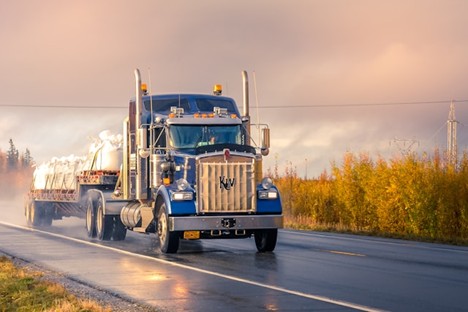
Truck drivers face a unique set of challenges on the road, balancing tight schedules, heavy loads, and long hours behind the wheel. According to expert trucking professionals, understanding the risks inherent in commercial driving is essential for both safety and accident prevention. While modern trucks are equipped with advanced safety features, the realities of road conditions, weather, and human error can still create significant dangers for truck operators. Recognizing and addressing these hazards is crucial not only for drivers but also for fleet managers, policymakers, and the general public who share the road with large commercial vehicles.
Weather conditions rank among the most unpredictable and hazardous elements truck drivers face. Rain, snow, ice, fog, and high winds can drastically alter road traction, visibility, and vehicle control. Wet or icy roads increase stopping distances, making it more difficult to navigate sharp curves or sudden traffic changes. Snow and ice, in particular, can accumulate on bridges and overpasses, creating localized patches of dangerous driving conditions. Fog and heavy rain reduce visibility, limiting a driver’s ability to see obstacles, other vehicles, or road signs in time to react safely.
High winds can also present a severe risk, especially for large trucks with high profiles that act like sails. Sudden gusts can destabilize trailers, particularly empty or lightly loaded ones, leading to potential rollovers. Truck drivers must remain vigilant in monitoring weather reports and adjusting speeds, routes, and driving behaviors to minimize the impact of these natural hazards.
The quality and condition of roadways significantly affect truck safety. Potholes, uneven pavement, and poorly maintained highways can lead to tire blowouts, loss of control, or suspension damage. Sudden lane shifts or detours without proper signage can catch drivers off guard, increasing the likelihood of accidents. Bridges, ramps, and highway interchanges often present unique challenges due to changes in grade, width, or alignment.
Construction zones are another common hazard. Workers, equipment, and temporary lane shifts create a dynamic environment that requires heightened awareness. Lane closures and narrow passages can be particularly challenging for trucks, which require more space to maneuver. Proper signage and adherence to speed reductions in these areas are essential, but driver alertness remains the most critical factor in avoiding collisions.
While trucks themselves are massive and powerful, the behavior of other drivers on the road can pose substantial risks. Sudden braking, tailgating, distracted driving, and improper lane changes are frequent causes of accidents involving commercial vehicles. Truck drivers must constantly anticipate and compensate for these unpredictable actions, often requiring rapid judgment and evasive maneuvers.
Driver fatigue is another major concern in the trucking industry. Long hours behind the wheel, combined with irregular sleep schedules, can impair reaction times and decision-making abilities. Regulatory measures such as mandatory rest breaks and hours-of-service limitations are designed to mitigate fatigue-related risks, but compliance and individual vigilance are critical. Fatigue not only increases the likelihood of errors but also reduces the ability to respond effectively to road hazards when they arise.
Large trucks have extensive blind spots that can obscure other vehicles, pedestrians, or obstacles. These blind zones, often referred to as “no-zones,” exist along the sides, rear, and directly in front of the truck. Drivers of smaller vehicles may underestimate the size of these blind spots, inadvertently placing themselves in dangerous positions. For truck operators, awareness of blind spots is essential, particularly when changing lanes, merging onto highways, or navigating through urban areas.
Nighttime driving further exacerbates visibility issues. Limited lighting, glare from other vehicles, and fatigue can reduce a driver’s ability to detect hazards in time. Many trucks are equipped with advanced lighting systems, reflective markers, and supplemental mirrors to enhance visibility, but constant vigilance and defensive driving remain indispensable tools for safety.
Mechanical issues are another significant hazard for truck drivers. Brake failures, tire blowouts, steering malfunctions, and engine problems can all lead to dangerous situations on the road. Regular maintenance is critical to preventing these incidents, including frequent inspections of tires, brakes, lights, suspension systems, and fluid levels. Preventative care not only ensures the vehicle operates safely but also protects drivers, cargo, and other road users from avoidable accidents.
Load security is also important for mechanical safety. Improperly secured cargo can shift during transit, altering the truck’s center of gravity and causing rollovers or jackknifing. Drivers must follow strict loading protocols, including weight distribution, tie-down procedures, and verification of securement before departure. Failure to adhere to these measures can lead to catastrophic consequences.
Truck drivers also encounter environmental hazards that may not immediately come to mind. Debris on the roadway, fallen tree limbs, or objects dropped from other vehicles can necessitate sudden evasive action, which can be especially dangerous for large, heavy trucks. Additionally, wildlife crossings pose risks, particularly in rural or forested areas. Collisions with animals such as deer, moose, or stray livestock can result in significant vehicle damage and endanger both driver and other motorists.
Flooded roadways are another environmental challenge, capable of compromising traction and causing hydroplaning. Drivers must exercise caution, assessing water depth and potential damage to the roadbed before proceeding. Understanding these environmental hazards and planning routes accordingly is an essential aspect of professional truck operation.
Heavy traffic and congestion in urban centers or on busy highways can create continuous hazards for truck drivers. Stop-and-go conditions increase the likelihood of rear-end collisions and make it difficult to maintain optimal following distances. Urban environments often feature tight turns, narrow lanes, and complex intersections that are challenging for large trucks to navigate.
Highway congestion presents its own set of challenges, including unpredictable lane changes, sudden braking, and erratic merging behaviors by other drivers. Skilled truck operators must adapt to these conditions while maintaining awareness of their vehicle’s limitations, ensuring safe stopping distances, and predicting traffic patterns to prevent accidents.

Modern trucks are increasingly equipped with advanced technologies designed to enhance safety and reduce the risks associated with common road hazards. Features such as lane departure warnings, automatic emergency braking, collision avoidance systems, and stability control can help prevent accidents or reduce their severity. GPS navigation, real-time traffic monitoring, and telematics systems allow drivers to anticipate hazards and plan routes more effectively.
However, technology is not a substitute for experience and vigilance. Even with advanced systems, truck drivers must rely on their training, judgment, and situational awareness to navigate the diverse hazards encountered on the road. Integrating human skill with technological assistance offers the best combination of safety and efficiency.
Truck driving is a complex profession that requires skill, alertness, and constant adaptation to changing conditions. Weather, road quality, traffic behavior, visibility challenges, mechanical issues, environmental hazards, and congestion all contribute to the risks that professional drivers face daily. Understanding these common road hazards is essential for drivers, fleet managers, and policymakers seeking to enhance safety on the road.
By prioritizing maintenance, remaining alert to environmental and human factors, and utilizing technology responsibly, truck drivers can mitigate many of the dangers inherent to the profession. Awareness, preparation, and proactive strategies are key to ensuring that commercial vehicles operate safely and efficiently, protecting both those behind the wheel and the broader public who share the roads with them.
While luck and circumstance can play a role in any journey, knowledge and preparation remain the most reliable tools for navigating the challenges of the road. Truck operators who respect these hazards and plan accordingly are best positioned to maintain safety, efficiency, and professionalism in an increasingly demanding industry.